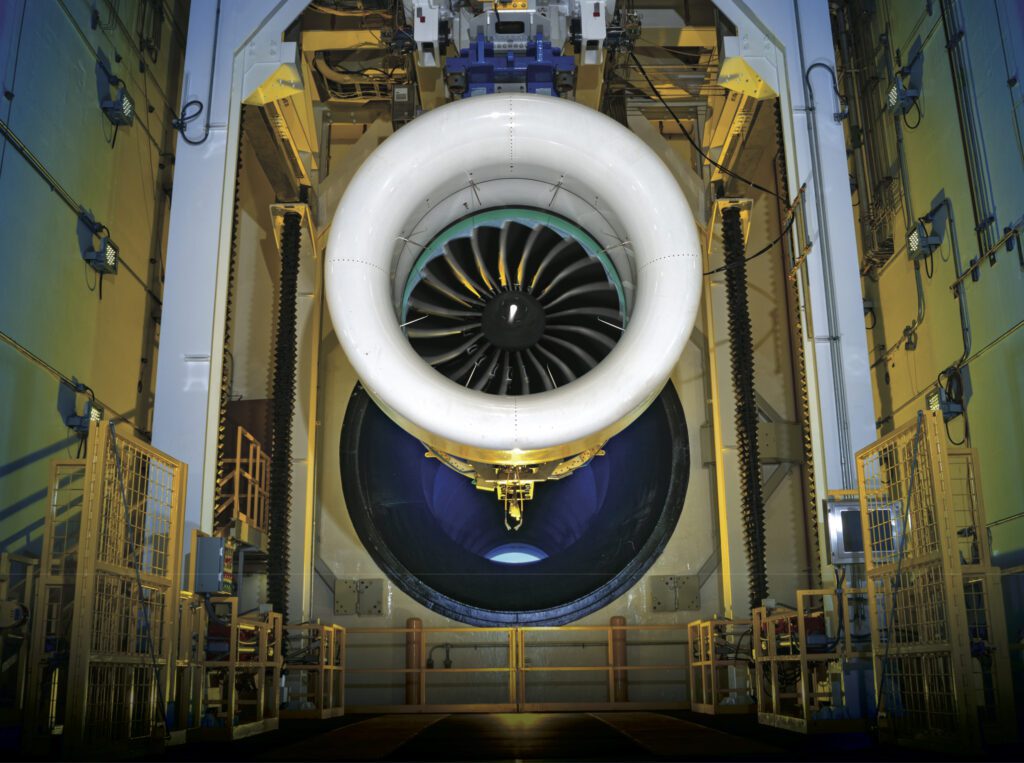
Pratt & Whitney was awarded a DoE project for the advancement of hydrogen propulsion technology. This week, another announcement from the company shared the successful completion of a test on its GTF Advantage engine configuration involving the use of 100% sustainable aviation fuel. Pictured is one of the company’s GTF engine testbeds. (Pratt & Whitney)
Last month, Pratt & Whitney was awarded a U.S. Department of Energy Project to develop hydrogen propulsion technology. As part of this project, they are working to develop highly efficient hydrogen-fueled propulsion technology for the commercial aviation industry. The project, referred to as HySIITE (Hydrogen Steam Injected, Inter-Cooled Turbine Engine), involves the use of liquid hydrogen combustion and water vapor recovery to power aircraft with zero in-flight CO2 emissions. Another aim is to reduce nitrogen oxide emissions by as much as 80%, and the team at Pratt & Whitney hopes to reduce aircraft fuel consumption by 35% for next-generation models.
Pratt & Whitney announced just this week that the team has successfully tested the use of 100% sustainable aviation fuel (SAF) to power its GTF Advantage engine configuration. Performing this test was a critical part of “an extensive development program to ready the GTF Advantage for entry into service in 2024, by validating the engine’s performance on 100 percent SAF in thrust transients, starting and operability,” according to the press announcement.

Pratt & Whitney’s GTF Advantage engine configuration was fueled with 100% sustainable aviation fuel in recent testing. (Photo: Pratt & Whitney)
Vince Sidwell, director of advanced concepts and technology for Pratt & Whitney, and his colleague Brent Staubach, associate director of advanced concepts and innovation, offered some insights on the company’s progress with hydrogen propulsion and SAF in an interview conducted via email with Avionics International. One of the most significant advancements from the company in recent years, according to Sidwell, is their GTFTM engine with geared turbofan technology. The engine “reduced fuel consumption and CO2 emissions by 16% for single-aisle aircraft,” he said, “along with having 50% lower NOx emissions, and a 75% smaller noise footprint. Already, 1,200 GTF-powered aircraft in service have saved the equivalent of 600 million gallons of fuel, and 6 million metric tons of CO2.”
The HySIITE project awarded by the Department of Energy to Pratt & Whitney will be a continuation of the company’s work in the hydrogen-fueled propulsion field, Sidwell said. “It is directed at the development of gas turbine technology that is optimized to take full advantage of the cryogenic properties of liquid hydrogen fuel. If successful, we believe that our targeted 35% improvement in fuel efficiency (on a gate-to-gate energy basis), will be of great significance to making hydrogen a viable and sustainable fuel source for future commercial aircraft.”
Staubach went into more detail about the HySIITE configuration. Their team intends to increase overall efficiency and reduce emissions by incorporating water and steam injection throughout the mission rather than just during takeoff. “The concept is designed to recover water from the engine’s exhaust gas, using a condenser. This water can then be turned into steam and injected into the combustor, resulting in greater engine thrust and lower NOx emissions. Water can also be used to cool parts of the engine, further improving efficiency,” he said.
To take this approach, Staubach explained, a consistent supply of water is necessary, and this is achieved via water vapor recovery. “Hydrogen combustion generates a significant amount of water vapor available for recovery, and the liquified hydrogen fuel provides a cold sink to enable condenser efficiency. The technology challenge is developing a flight-weight and volume water recovery system.”
Three key focal points of the project are integrated system evaluation, notional component design, and component feasibility tests. While the HySIITE program does not include plans to perform any engine demonstrations, it does lend itself to accelerated ground demonstration, which could be done with off-the-shelf engines, Staubach wrote. He added that if there is sufficient funding, the HySIITE concept could potentially support entry into service of an aircraft sometime after 2035. “Viable service entry will also depend on incorporating the engine into an aircraft designed to carry hydrogen fuel and having a hydrogen delivery infrastructure available at airports.”
“We recognize that our technologies have a significant role in making this net-zero goal a reality—both through our drive to continually improve engine efficiency, and through our work to enable the use of non-fossil based alternative fuels, such as SAF and hydrogen,” Sidwell said. He added that the company has several test programs underway geared towards operation of engines with 100% SAF in the future. “We have committed to making next-generation engines like the GTF Advantage compatible with 100% SAF. We’re excited to also develop hydrogen technologies through the HySIITE project, which could contribute to net zero emissions by 2050 and the decades beyond.”